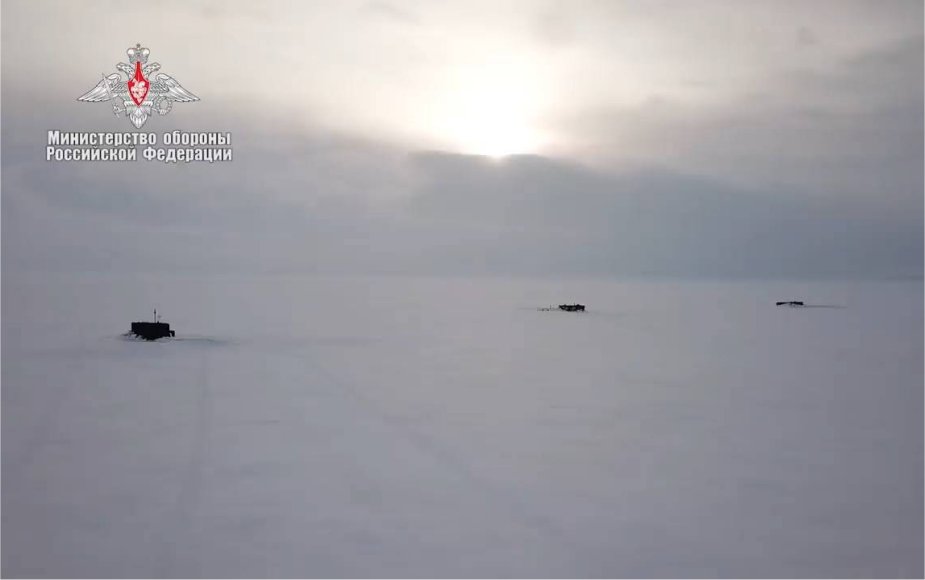Breaking news
Russia will send submarines to consolidate its interests in the Arctic.
According to information published by Tass on August 1, 2022, Russia will pay increased attention to the development of the Arctic in the coming years. Project 949 nuclear-powered submarines will be on duty in the Arctic waters to ensure the security of the Northern Sea Route.
Follow Navy Recognition on Google News at this link
 Three Russian nuclear-powered submarines break thick ice and surface in the Arctic Ocean. (Picture source: Russian MoD)
Three Russian nuclear-powered submarines break thick ice and surface in the Arctic Ocean. (Picture source: Russian MoD)
As the Defense Ministry told the Izvestiya newspaper, Pacific Fleet nuclear-powered submarines held drills in the spring and earlier this summer to practice covering the Northern Sea Route.
The drills were carried out in order to assess the capabilities of Project 949 submarines in the Arctic region. During the exercises, the submarines operated in the waters of the Northern Sea Route, occasionally surfacing in ice conditions.
Coverage of the most important Arctic route can be provided by Project 949 submarines being considered the most effective surface ship and submarine hunters.
The Project 949 submarines were built in the 1980s and 1990s, being among the last subs of the Soviet shipbuilding industry. They were developed under the guidance of prominent Soviet shipbuilder Igor Baranov, who was appointed project general designer in 1977.
Today, three submarines of this series, namely the Tver, Omsk and Tomsk, are operational with the 10th submarine division of the Pacific Fleet. The other two subs, the Smolensk and the Oryol, are in service with the 11th division of the Northern Fleet.
The Project 949 submarines were originally designed to combat naval surface forces, being carriers of torpedoes and Granit missiles. In addition to fighting aircraft carriers, these submarines can destroy enemy amphibious assault forces and counter transport convoys. According to the newspaper, not so long ago, the Project 949 submarines began to train missile strikes against ground targets.
During the exercises, antisubmarine and antiship operations were carried out in the northern part of the Pacific Ocean in order to prevent naval forces of unfriendly countries from entering the water area. Future maneuvers of the Northern Fleet will be dedicated to the protection of the western section of the Northern Sea Route.
Exercises to protect the Northern Sea Route are being held, among other things, due to global climate changes. The ice area in the Arctic Ocean will shrink in the near future, as a result, huge amounts of water will be released and the threat of enemy surface forces penetrating into the region will increase.
Control over the waterways of the Northern Sea Route is Russia’s most important strategic advantage, the Izvestiya experts believe. Various hostile acts of provocation by the United States are possible in this area, which makes it necessary to cover it.
The Russian Navy has already accepted for service the submarine BS-329 Belgorod, which was developed on the basis of the Project 949 sub. During the construction, the submarine was modified. In its central part, where the missile silos were previously deployed, an additional 30-meter compartment was built.
The modified submarine has a length of more than 180 m, which is 11 m more than the largest Project 941 Akula-class nuclear-powered submarine and 12 m more than the US Ohio-class submarine.
The BS-329 submarine was upgraded to carry the AS-31 Losharik underwater craft and Poseidon 'doomsday' torpedoes. Along with military tasks, the Belgorod can also carry out research activities.
Strategic route
The newspaper writes that since the middle of the last decade, Russia has been actively building military infrastructure along the Northern Sea Route and in the polar areas. Last year, the Northern Fleet Joint Strategic Command became equal to a military district.
Units of Bal and Bastion coastal missile systems, as well as air defense missile systems, are based on the Russian islands in the Arctic. In recent years, about 20 airfields built during the Soviet period have been repaired or reconstructed.
They are located on Alexandra Land in the Franz Josef Archipelago and Kotelny Island in the Novosibirsk archipelago and can receive aircraft in any weather and all year round.
In November 2021, honored military pilot Major General Vladimir Popov told TASS that upgraded MiG-31 fighters would be based at the reconstructed airfields, covering the Northern Sea Route.
Redeployment of various forces to the Arctic region has been regularly practiced lately. In November 2021, crews of Iskander-M tactical missile systems were alerted and airlifted to the Novaya Zemlya archipelago to practice missile live-firing. In 2021, Northern Fleet ships trained amphibious assault along the Northern Sea Route.
President Vladimir Putin said in 2021 that Russia was setting up environmental infrastructure in the Arctic region. In addition, a base of the Emergencies Ministry is being created in the Arctic, which will save people and protect the environment.
According to the Russian president, as the climate changes in the region and more and more icebreakers appear, navigation along the Northern Sea Route will become year-round.




























